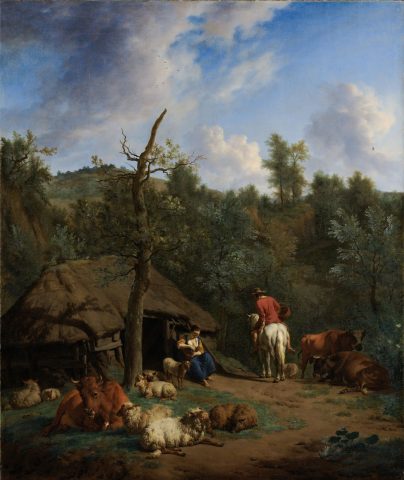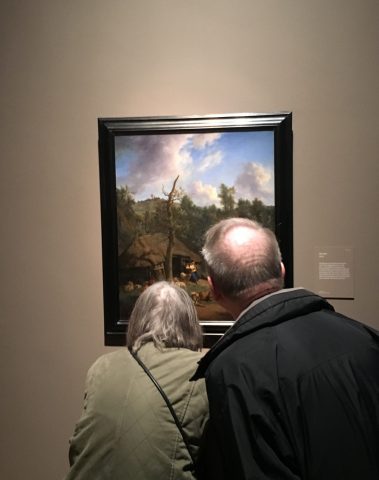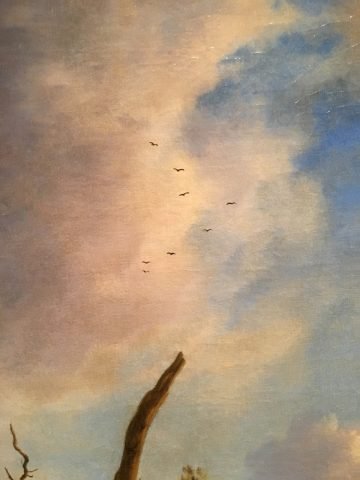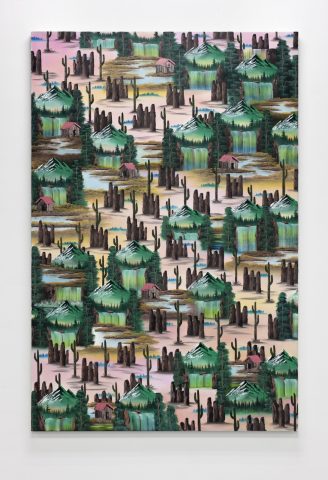At the show with the artist: Neil Raitt on Adriaen Van De Velde at the Dulwich
- Adriaen van de Velde, The hut, 1671, oil on canvas, 76 x 65 cm, courtesy of Rijksmuseum, Amsterdam.
- Adriaen van de Velde, The hut.
- Adriaen van de Velde, detail.
- Neil Raitt, “Mountain Waterfall”, 2016 Oil on canvas, 180 x 120 cm. Courtesy of the artist.
Today I visited an exhibition of work by Adriaen Van De Velde at The Dulwich Picture Gallery in South East London.
I wasn’t aware of his work before going to see the exhibition, but I have discovered one or two artists through exhibitions at The Dulwich Picture gallery in the past so I thought it might be a bit of craic. I think the program has a way of shedding light on slightly forgotten or overlooked artists, in a way that doesn’t try too hard to re-contextualise them.
The exhibition is a survey of his life’s work. Although he was a prolific painter, he died at the young age of 35. There are several masterpieces in the show, that are supplemented by a large number of works on paper and preparatory studies. It is a Friday afternoon and there are a handful of other visitors that are also taking their time through the slightly sleepy galleries of the exhibition.
One of the rooms is dedicated to a painting titled The Hut. It is a modestly sized painting that depicts what looks like a shepherdess working on a basket, while a man sits on a horse close by. The arbitrary nature of the scene is bathed in warm light. It has a kind of ornamental quality to the way it is painted, almost as though it could actually have been made out of porcelain.
I am here with a friend of mine, Joshua Sex.
We studied painting together at the RCA and for the past year or so he has begun to focus his attention on story writing. He tells me he has been enjoying writing at home in the day, using a pen and paper, and resisting turning on his laptop until around 8pm. He tells me when it starts to get dark around 5/6pm, and it becomes too difficult to write anymore without turning on the light, he watches the tree outside of his window until it disappears into darkness. He says his sense of time somehow changes, in retrospect, and it feels like a kind of meditation.
As we’re walking through the exhibition, one of the main things that stands out about the work is the use of colour. The Hut is made up of bright, complimentary colours that seem to make the painting glow. It reminds me of the different role that painting would have played as a visual device. In this way, the idea of craft is something that would have been closer to home. The disparity between art and craft has become much more pronounced in modern society, as the boundaries of what each thing can be continues to grow. However, as a metaphor for painting, I am interested in these boundaries and what happens when they cross over and become blurred again.
Also in the same room are a number of preparatory sketches for the painting that shows how each of the different elements of the scene were explored and familiarised by the artist visually, before committing himself to them fully in the painting. While each of the sketches are a direct reflection of the painting, they also offer further clues as to the narrative of the wider scene that is at play in the work. A preliminary drawing of the hut for example, remains almost entirely unchanged in its transition for the drawing to the painting. This gives the painting a sense that it was created with a collection of images already a part of the artists’ wider consciousness, and something that I associate closely as a contemporary device rather than classical.
I thoroughly enjoyed this exhibition, and would recommend it to anyone who wants to get outside of themselves for an hour or two and imagine the golden light coated world of Holland in the 1600’s.
* Neil Raitt (1986) is a London based artist currently represented by Anat Ebgi gallery. His painting is committed to the ‘primitive figural‘ neuroscientist Vilayanur S. Ramachandran calls repetition. Raitt references may range from Donald Judd and Walter De Maria’ instrumental installations to contemporary masters such as Ai Wei Wei and Damien Hirst, who also largely use repetition, particularly in their three-dimensional works. But generally the first thing coming to mind beholding a Raitt’s painting are chintzy wallpapers and a popular television program by Bob Ross, ‘The Joy of Painting‘. So you may think that Raitt is not only aware of Pop culture effectiveness, but he is also confident with the kind of fundamental “lightness” that Italo Calvino analysed in his American Lessons.
Raitt’s upcoming exhibitions in 2017 include ‘Flirty, but not too much’ at CAC La Halle des Bouchers, Vienne, France (curated by Marc Bembekoff), and a solo show at Anat Ebgi Gallery, LA.
November 15, 2016




